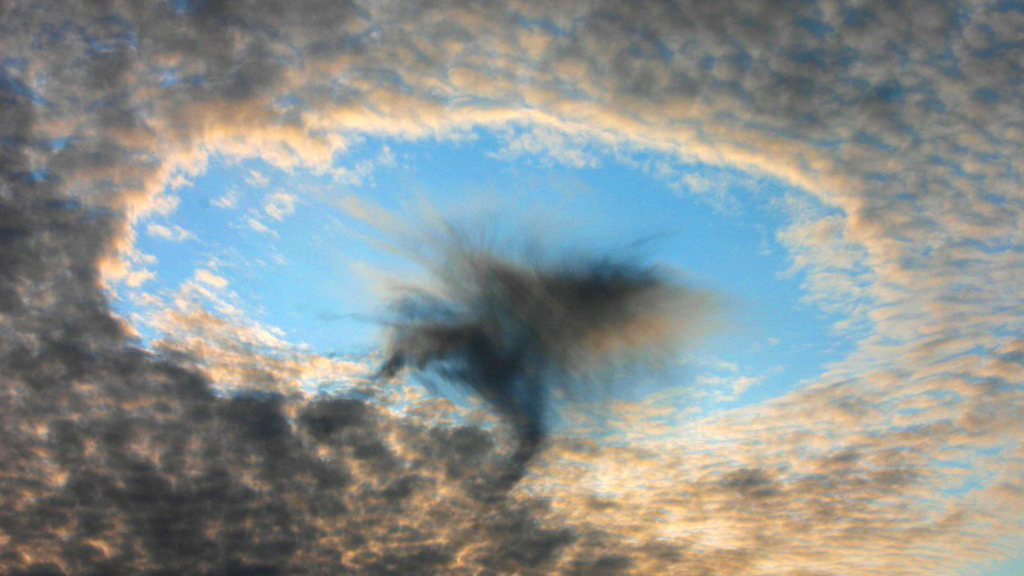Fallstreak holes
What’s that funny hole in the clouds?
Standing outside your hangar, gazing skyward, have you ever seen an unusually sharp hole in the cloud deck above? If you have, was it circular, elliptical, or possibly square or rectangular?

There are times when these holes look so odd, so neatly cut through the clouds that some people believe they are evidence of a UFO arrival, or perhaps a departure with cows aboard. Personally, I think it’s a sign for me to take off in search of pancakes, not ET.
You can champion the UFO theory or demonstrate your vast meteorological knowledge by explaining to your fellow pilots that this unusual phenomenon is known as a fallstreak hole, sometimes also called a hole punch cloud, cloud canal, skypunch, or cloud hole. Or, to sound extra brainy, you could identify it as a “cavum,” a Latin word that means “cavity.”
Fallstreak holes sometimes appear in mid- to high-level cirrocumulus or altocumulus clouds, common clouds that are primarily composed of supercooled water droplets, which is water that is below the freezing point, but still remains liquid. Below freezing, but not frozen? How’s that work? As Professor Proton would tell us, water normally freezes at 32 degrees Fahrenheit (0 degrees Celsius), but there are exceptions. Water suspended in very clean air can be chilled below 32 degrees F and still remain liquid, a process known as “supercooling.” In addition to cold temperatures, water usually requires small particles—impurities such as dust, pollution, fungal spores, or even tiny bacteria—to act as nucleation points on which the ice crystals can form. Without these particles, water can remain liquid in sub-freezing temperatures, becoming “supercooled.” This can happen at high altitudes where there are few particles to trigger the crystallization. However, this supercooled water is also very unstable and will flash-freeze when disturbed or suddenly cooled further.
Supercooling occurs frequently in the atmosphere. Altocumulus clouds, which are common in the mid-altitudes, are usually composed of supercooled water droplets at about 5 degrees F. These clouds cover about eight percent of the Earth at any time.
According to NOAA, fallstreak holes are formed when an aircraft passes through these types of clouds. The aircraft’s movement causes the air flowing over its wings and fuselage to expand and cool, a process known as adiabatic cooling. Jet wings can cool the air by as much as 36 degrees F, causing the supercooled water droplets to freeze into tiny ice crystals without the help of airborne particles.
As the crystals form, they absorb nearby water droplets, growing until they are heavy enough to fall from the cloud, leaving a hole behind. These ice crystals can sometimes be seen falling as virga. I assume the name “fallstreak” comes from the feathery wisps of ice crystals that are sometimes seen falling from the cloud hole. While you’re explaining fallstreak holes to everyone at the office party, you can add that virga (sometimes called a dry storm) is precipitation that evaporates or sublimates before reaching the ground. At high altitudes, virga is usually composed of ice crystals which melt into rain before evaporating above the ground.
Sometimes you’ll see very elongated fallstreak holes and these are known as “canal clouds.” Whether the hole is circular or elliptical depends on the cloud thickness, air temperature, horizontal wind shear, and the aircraft’s vertical speed. Both descending and ascending aircraft—including jets and propeller airplanes—can trigger fallstreak and canal clouds. I’ve seen cloud holes with straight sides in the shape of a rectangle and you can find photographs online showing square holes. Because of these unusual appearances and their rarity, fallstreak holes have sometimes been attributed to UFOs. By whom, I don’t know.
In the past, scientists observed this phenomenon and mentioned it in scientific journals, speculating about their creation, but it wasn’t until the twenty-first century that anyone really investigated. Sensible research by sensible scientists at the University Corporation for Atmospheric Research (a nonprofit association of universities that provide research and education in atmospheric and related sciences) determined that fallstreak holes are caused by airplanes, not ET. They also learned that when airplanes pass through clouds at a steep angle, smaller, circular holes appear, whereas if they cruised through the wispy stuff at a shallow angle, then longer elliptical “canal clouds” resulted. They reported that almost any aircraft type from jumbo jets to private jets, military aircraft, and turboprops can produce fallstreak holes. They didn’t mention the effect of flying saucers. 


